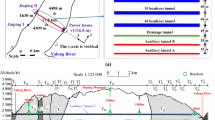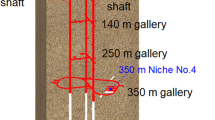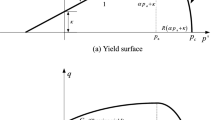Abstract
Excavation of deep underground openings induces permeable fractures around the opening due to stress redistribution. Such a zone is called excavation damaged zone (EDZ). In a high-level radioactive waste disposal project, the EDZ might provide pathways for the migration of radionuclides around the facility. Thus, this study focused on the development of a method for estimating the highest potential hydraulic conductivity in the EDZ around a gallery in the Horonobe Underground Research Laboratory, Japan. Borehole televiewer surveys, rock core observations, and hydraulic tests were undertaken to investigate the extent and magnitude of hydraulic conductivity in the EDZ around the gallery. The observed extent (sidewall ≤ 0.6 m; floor ≤ 1.6 m) of the EDZ shows good agreement with the EDZ estimated from hydro-mechanical coupling analysis. The measured hydraulic conductivities of the EDZ (3.5 × 10−6 to 1.24 × 10−8 m/s) are within the range of those based on the Mean Stress Index (MSI), which is defined as the ratio of the effective mean stress derived from numerical analyses to the tensile strength of intact rock. Given that the rock mass is relatively homogeneous and artificial damage (e.g., blasting-induced damage) can be neglected, as in the Horonobe Underground Research Laboratory, the MSI model is likely to be applicable in estimating the highest potential hydraulic conductivity in the EDZ.



Reproduced with permission from Diederichs (2003)




















Similar content being viewed by others
References
Aoyagi K, Tsusaka K, Tokiwa T, Kondo K, Inagaki D, Kato H (2013) A study of the regional stress and the stress state in the galleries of the Horonobe Underground Research Laboratory. In: Proceedings of the 6th International Symposium on In-Situ Rock Stress. Sendai. Japan. pp 331–338
Aoyagi K, Tsusaka K, Nohara S, Kubota K, Tokiwa T, Kondo K, Inagaki D (2014) Hydrogeomechanical investigation of an excavation damaged zone in the Horonobe Underground Research Laboratory. In: Proceedings of the 8th Asian Rock Mechanics Symposium, Sapporo, Japan. pp 2804–2811
Aoyagi K, Ishii E, Kondo K, Tsusaka K, Fujita T (2015) A study on the strength properties of the rock mass based on triaxial tests conducted at the Horonobe Underground Research Laboratory. Technical Report. Japan Atomic Energy Agency, JAEA-Research 2015-001
Aoyagi K, Ishii E, Ishida T (2017) Field observation and failure analysis of an Excavation Damaged Zone in the Horonobe Underground Research Laboratory. J MMIJ 133:25–33
Armand G, Leveau F, Nussbaum C, Vaissiere RL, Noiret A, Jaeggi D, Landrein P, Righini C (2014) Geometry and properties of the excavation-induced fractures at the Meuse/Haute-Marne URL drifts. Rock Mech Rock Eng 47:21–41
Baechler S, Lavanchy JM, Armand G, Cruchaudet M (2011) Characterisation of the hydraulic properties within the EDZ around drifts at level—490 m of the Meuse/Haute-Marne URL: a methodology for consistent interpretation of hydraulic tests. Phys Chem Earth 36:1922–1931
Bieniawski ZT (1967) Mechanism of brittle fracture of rock, parts I, II and III. Int J Rock Mech Min Sci 4:395–430
Blümling P, Bernier F, Lebon P, Martin CD (2007) The excavation damaged zone in clay formations time-dependent behavior and influence on performance assessment. Phys Chem Earth 32:588–599
Bossart P, Meier PM, Moeri A, Trick T, Mayor JC (2002) Geological and hydraulic characterization of the excavation disturbed zone in the Opalinus Clay of the Mont Terri Rock Laboratory. Eng Geol 66:19–38
Bossart P, Trick T, Meier PM, Mayor JC (2004) Structural and hydrogeological characterization of the excavation-disturbed zone in the Opalinus Clay (Mont Terri Project, Switzerland). Appl Clay Sci 26:429–448
Chen Y, Hu S, Zhou C, Jing L (2014) Micromechanical modeling of anisotropic dmage-induced permeability variation in crystalline rocks. Rock Mech Rock Eng 47:1775–1791
Diederichs MS (2003) Rock fracture and collapse under low confinement conditions. Rock Mech Rock Eng 36:339–381
Diederichs MS (2007) Mechanistic interpretation and practical application of damage and spalling prediction criteria for deep tunneling. Can Geotechn J 40:1082–1116
Guayacan-Carrilo L-M, Ghabezloo S, Sulem J, Seyedi DM, Armand G (2017) Effect of anisotropy and hydro-mechanical couplings on pore pressure evolution during tunnel excavation in low-permeability ground. Int J Rock Mech Min Sci Geomech Abstr 97:1–14
Hvorslev M (1951) Time lag and soil permeability in ground-water observations: waterways, experiment St. Corps of Engineers. U.S. Army Bull 36:49
Inoue J, Kim H-M, Horii H (2005) Estimation of hydraulic property of jointed rock mass considering excavation-induced change in permeability of each joints. Soils Found 45:43–59
International Society for Rock Mechanics (1978a) Suggested methods for determining tensile strength of rock materials. Int J Rock Mech Min Sci Geomech Abstr 15:99–103
International Society for Rock Mechanics (1978b) Suggested methods for determining sound velocity. Int J Rock Mech Min Sci Geomech Abstr 15:53–58
International Society for Rock Mechanics (1979a) Suggested methods for determining the uniaxial compressive strength and deformability of rock materials. Int J Rock Mech Min Sci Geomech Abstr 16:135–140
International Society for Rock Mechanics (1979b) Suggested methods for determining water content, porosity, density, absorption and related properties and swelling and slake-durability index properties. Int J Rock Mech Min Sci Geomech Abstr 16:143–151
International Society for Rock Mechanics (1983) Suggested methods for determining the strength of rock materials in triaxial compression: revised version. Int J Rock Mech Min Sci Geomech Abstr 20:285–290
Ishii E (2015) Predictions of the highest potential transmissivity of fractures in fault zones from rock rheology: preliminary results. J Geophys Res Solid Earth 120:2220–2241
Ishii E (2016) Far-field stress dependency of the failure mode of damage-zone fractures in fault zones: Results from laboratory tests and field observations of siliceous mudstone. J Geophys Res Solid Earth 121:70–91
Ishii E (2017a) Preliminary assessment of the highest potential transmissivity of fractures in fault zones by core logging. Eng Geol 221:124–132
Ishii E (2017b) Estimation of the highest potential transmissivity of discrete shear fractures using the ductility index. Int J Rock Mech Min Sci 100:10–22
Itasca Consulting Group Inc (2009) FLAC3D Fast Lagrangian analysis of continua in 3 dimensions user’s guide. Itasca Consulting Group Inc., Minneapolis
Japan Nuclear Cycle Development Institute (2000) H12: project to establish the scientific and technical basis for HLW disposal in Japan—report 3 safety assessment of the geological disposal system. Technical report. JNC TN1410 2000-004, Tokai-mura, Japan
Japan Society of Civil Engineers (2002) Standard specifications for concrete structures—2002, materials and construction. JSCE Guidelines for Concrete, Maruzen
Kulander BR, Dean SL, Ward BJ Jr (1990) Fractured core analysis: interpretation, logging, and use of natural and induced fractures in core. In: AAPG methods in exploration series 8. AAPG, Oklahoma
Kurikami H, Takeuchi R, Yabuuchi S (2008) Scale effect and heterogeneity of hydraulic conductivity of sedimentary rocks at Horonobe URL site. Phys Chem Earth 33:537–544
Lajtai EZ (1974) Brittle fracture in compression. Int J Fract 10:525–536
Martin CD, Lanyon GW (2003) Measurement of in-situ stress in weak rock at Mont Terri Rock Laboratory, Switzerland. Int J Rock Mech Min Sci 40:1077–1088
Mezawa T, Mochizuki A, Miyakawa K, Sasamoto H (2017) Groundwater pressure records by geochemical monitoring system in the Horonobe Underground Research Laboratory. Technical Report. JAEA-Data/Code 2017-010
Miyazawa D, Sanada H, Kiyama T, Sugita Y, Ishijima Y (2011) Proelastic coefficients for siliceous rocks distributed in the Horonobe area, Hokkaido, Japan. J MMIJ 127:132–138
National Astronomical Observatory (2005) Chronological scientific tables 2005. Maruzen, Tokyo
Ota K, Abe H, Kunimaru T (2010) Horonobe Underground Research Laboratory Project Synthesis of Phase I Investigations 2001–2005 volume “Geoscientific Research”. Technical Report. JAEA-Research 2010-068
Perras MA, Diederichs MS (2014) A review of the tensile strength of rock: concepts and testing. Geotech Geol Eng 32:525–546
Rutqvist J, Börgesson L, Chijimatsu M, Hernelind J, Jing L, Kobayashi A, Nguyen S (2009) Modeling of damage, permeability changes and pressure responses during excavation of the TSX tunnel in granitic rock at URL, Canada. Environ Geol 57:1263–1274
Sato T, Kikuchi T, Sugihara K (2000) In-situ experiments on an excavation disturbed zone induced by mechanical excavation in neogene sedimentary rock at tono mine, central Japan. Eng Geol 56:97–108
Shao H, Schuster K, Sönnke J, Bräuer V (2008) EDZ development in indurated clay formations—in situ borehole measurements and coupled HM modeling. Phys Chem Earth 33:5388–5395
Shen B, Stephansson O, Rinne M, Amemiya K, Yamashi R, Toguri S, Asano H (2011) FRACOD modeling of rock fracturing and permeability change in excavation damaged zones. Int J Geomech 11:302–313
Souley M, Armand G, Kazimerczak JB (2017) Hydro-elasto-viscoplastic modeling of a drift at the Meuse/Haute-Marne underground research laboratory (URL). Comput Geotech 85:306–320
Suko T, Takano H, Uchida M, Seki Y, Ito K, Watanabe Y, Munakata M, Tanaka T, Amano K (2013) Research on validation of the groundwater flow evaluation methods based on the information of geological environment in and around Horonobe underground research area. JNES (Japan Nuclear Energy Safety Organization) RE Report series JNES-RE-2013-9032
Tsang CF, Bernier F, Davies C (2005) Geohydromechanical processes in the excavation damage zone in crystalline rock, rock salt, and indurated and plastic clays in the context of radioactive waste disposal. Int J Rock Mech Min Sci 42:109–125
Vermeer PA, de Borst R (1984) Non-associated plasticity for soils, concrete and rock. Heron 29:3–64
Wang HF (2000) Theory of linear poroelasticity with applications to geomechanics and hydrogeology. Princeton University Press, Princeton
Wileveau Y, Bernier F (2008) Similarities in the hydromechanical response of Callovo-Oxfordian clay amd Boom Clay during gallery excavation. Phys Chem Earth 33:S343–S349
Xu WJ, Shao H, Hesser J, Wang W, Schuster K, Kolditz O (2013) Coupled multiphase flow and elasto-plastic modelling of in-situ gas injection experiments in saturated claystone (Mont Terri Rock Laboratory). Eng Geol 157:55–68
Yamamoto T, Aoki T, Joh M (2005) Investigation on time-dependent behavior of sedimentary rock (Phase3). Technical Report. JNC TJ5400 2005-002
Yong S, Kaiser PK, Loew S (2010) Influence of tectonic shears on tunnel-induce fracturing. Int J Rock Mech Min Sci 47:894–907
Yong S, Kaiser PK, Loew S (2013) Rock mass response ahead of an advancing face in faulted shale. Int J Rock Mech Min Sci 60:301–311
Zoback MD (2007) Reservoir geomechanics. Cambridge University Press, Cambridge
Acknowledgements
Takayuki Motoshima, Mitsuyasu Shirase, and Sumio Niunoya of the Taisei–Obayashi–Mitsuisumitomo Joint Venture Group planned and managed the in situ experiments conducted at the URL. Seiji Kikuyama of Asano Taiseikiso Engineering conducted the hydraulic tests in the URL. Junji Kita of Raax conducted the BTV surveys in the URL. Kentaro Sugawara of Geoscience Research Laboratory kindly supported our analysis. We appreciate their assistance and valuable comments. We also thank three anonymous reviewers for helpful comments and the Editor-in-Chief Giovanni Barla for editorial handling of the manuscript.
Author information
Authors and Affiliations
Corresponding author
Additional information
Publisher’s Note
Springer Nature remains neutral with regard to jurisdictional claims in published maps and institutional affiliations.
Rights and permissions
About this article
Cite this article
Aoyagi, K., Ishii, E. A Method for Estimating the Highest Potential Hydraulic Conductivity in the Excavation Damaged Zone in Mudstone. Rock Mech Rock Eng 52, 385–401 (2019). https://doi.org/10.1007/s00603-018-1577-z
Received:
Accepted:
Published:
Issue Date:
DOI: https://doi.org/10.1007/s00603-018-1577-z




